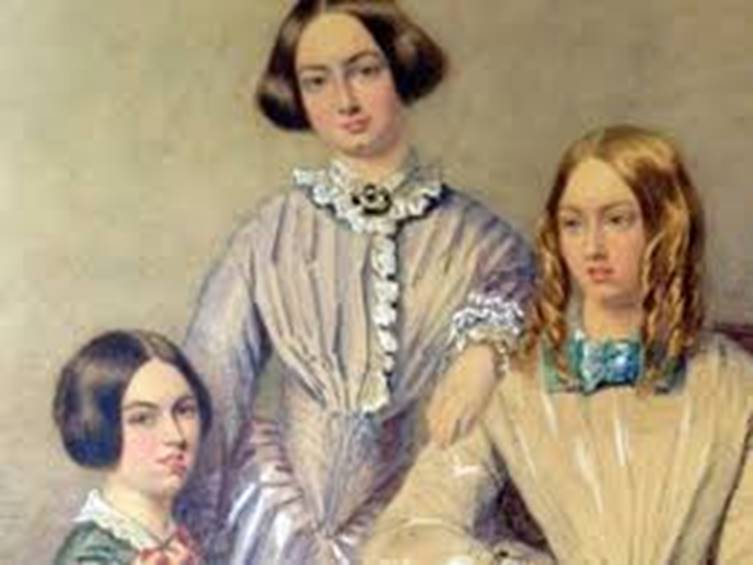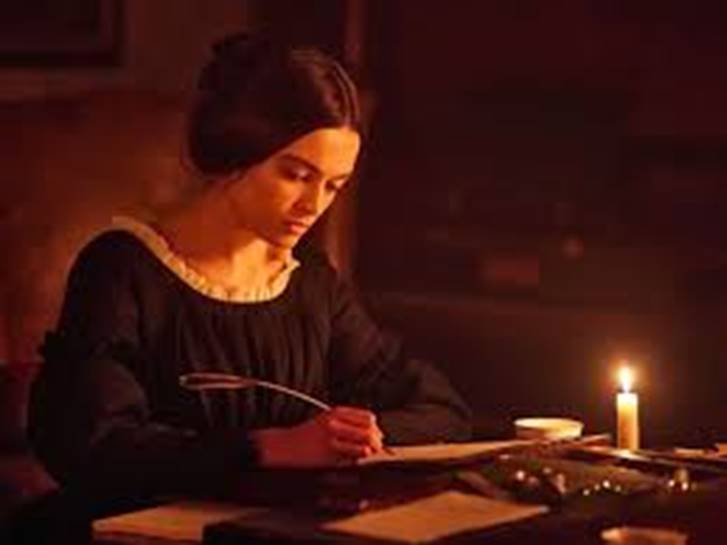
The Story of the Bronte Sisters
By Dr Asif Javed
Williamsport, PA
Some time ago, this writer came upon an article in Pakistan Link about Urdu fiction writer, Hajra Masroor, who died recently. The article described Hajra and her two sisters as the Bronte Sisters of Urdu literature. Hajra Masroor and her sister Khadija Mastoor were prolific and successful writers and may have their place secured in Urdu literature. But who were the Bronte sisters they were being compared to? Herein lies the answer:
Charlotte and her sisters, Emily and Anne, were born to a clergy of Irish descent who worked in a small village Haworth, in West Yorkshire, England, in the first half of the nineteenth century. Their mother died when they were very young and they were brought up by their widowed father and a maternal aunt who moved in with the family. They had two elder sisters too, who died at a very young age, on contracting TB at school.
The family was not wealthy and the girls had to work as governesses at times, to support themselves. After finishing school, Charlotte and Anne spent some time in Brussels, learning French and music. It was upon their return home that their life story became rather unusual.
Mr Bronte, their father, despite his humble origins in Ireland, had studied at Cambridge University and had a literary taste. It seems that he passed on this trait to his children. He owned a small library and had once brought a gift of toy soldiers from Leeds for his son. Unbeknownst to him, his children had started using those toy soldiers as characters for their stories and plays. Haworth is as rural a place as they come. It is surrounded by gentle rolling hills, known as the moors. The family had very little contact with the village folks, barring elder Mr Bronte’s work in the church. There was plenty of time. So, what did the sisters do? They would walk on the moors for hours during the day, and in the evening, instead of sitting idly by, they would write.
Charlotte’s friend and biographer, Elizabeth Gaskell, has left a detailed account of their routine. We are told they would get together after supper in the parlor and would walk around the table, pacing up and down, while discussing the plots of their stories with each other. It was during one of those sessions that Charlotte said to her sisters with earnest conviction: “My heroine, in Jane Eyre, is going to be unattractive, small and plain.” Before long, they had completed three novels, ready for publication. But then they ran into a predicament.
Odd as it sounds, it was all being done in complete secrecy. Nobody, other than the three sisters, had any idea of their work. In the Victorian era, women writers were almost unheard of. Thus, the sisters wanted to preserve their privacy. Years later, Charlotte was to say, “The most profound obscurity is infinitely preferable to vulgar notoriety that I neither seek nor will have.” And so, they sent their manuscripts to a London publisher, with assumed, masculine sounding names: Currer, Ellis and Acton Bell. After many disappointments, Jane Eyre, Wuthering Heights and Tenant of Wildfell Hall, were eventually published.
Jane Eyre and Wuthering Heights became massive hits. Almost overnight, the authors had become literary celebrities. There had been rave reviews of the books in newspapers, including The Times of London. And yet, nobody seemed to know the real identity of the authors. There was intense speculation. Even the publisher had only a vague idea until one day, two shy young women with Yorkshire accent, turned up at his London office. Their identities revealed, they returned home in haste, having asked him to keep their secret.
Unfortunately, as the gods of good fortune were beginning to smile at them, a series of tragedies started to strike. To begin with, their only brother, Patrick Bronte, who may have been the most gifted in the family, fell in bad company. He could not hold a steady job and became an opium addict after a disastrous affair with a much older, married woman. He incurred a lot of debt, went through severe depression and died of alcoholism; he was thirty at the time of his death.
Within weeks, Emily, whose Wuthering Heights remains popular to this day, came down with TB and perished soon afterwards; she was only twenty-nine. The family had barely recovered from the twin tragedy when Anne, the author of Tenant of Wildfell Hall and Agnes Grey, also developed pleurisy. Charlotte took her to the seaside town of Scarborough, at her dying sister’s request. Anne had visited and liked the place while working as governess as a teenager. Anne died within days of going to Scarborough. Heartbroken, Charlotte went through the ordeal of burying her last sibling, away from home, all by herself, in an attempt to spare her aged father, the pain of yet another offspring’s burial.
Charlotte returned home and eventually got married to her father’s assistant, Arthur Nichols who had been wooing her for some time. After marriage, she looked happy at last, having endured so much pain but this was not to last. She became pregnant and developed severe Hyperemesis Gravidarum, a pregnancy-related condition that led to intractable vomiting. As her life was ebbing fast, she whispered to her husband, “Oh! I am not going to die; am I? He will not separate us; we have been so happy.” Charlotte Bronte died at the age of thirty-nine, leaving her aggrieved father and husband to mourn her. And so, over a period of just seven years, the most celebrated literary family of its time had been wiped out. Ironically, the elder Mr Bronte outlived all his talented children.
On a visit to Haworth a few years ago, this writer wondered how on earth did the Bronte sisters, who had had so little exposure to the outside world, had come up with their stories. It seems that they nurtured their hereditary literary talent with keen observation of their environment. Cathy’s character in Wuthering Heights - the heart-wrenching story of doomed love between Cathy and Heathcliff, a role played by incomparable Lawrence Olivier, on screen - has, in fact, many similarities to the author Emily Bronte who created her heroine just like herself: stubborn, impulsive and sensitive. Charlotte’s less famous novel Shirley is also the story of her sister, Emily. The infamous Lowood School mentioned in Jane Eyre is based on the Cowans Bridge School that the Bronte sisters had attended, while the character of Helen Burns in Jane Eyre was based on their sister, Maria, who had died of TB while at school. And yes, the cruel school teacher in Jane Eyre was also based upon one of the real teachers of that school.

One can’t but admire the Bronte sisters’ tenacity. They may have had God-given talent bestowed upon them but their manuscripts were rejected several times. However, repeated disappointments did not deter them. Charlotte’s first novel, Professor, was rejected by no less than four publishers. But she persevered. Her magnum opus, Jane Eyre, was started in a dark hospital room in Manchester, where she had been nursing her father after cataract surgery. Amid the loneliness, depression and a severe toothache, she started writing. It is hard to imagine more bleak circumstances for a writer. Little did she realize that she had embarked upon a story that was going to make her a legend.
This writer recalls a time in the late 60’s when Jane Eyre was part of the BA curriculum in Pakistan. Dilip Kumar reportedly was so fascinated with the Bronte sisters that he alone had acted in four movies based on their stories. Between the three sisters, Charlotte wrote the most; she also outlived her siblings. Her biographer notes that Charlotte had been an indefatigable student, fond of reading from a very young age. Her demeanor was of a shy and reserved person. Some of her letters have survived and give the impression that she was a pessimist, and may have suffered from depression. Here are some excerpts:
“My youth is gone like a dream. What have I done in the last thirty years? Precious little ---Hope and fear fluctuate daily. I have endured such tortures of uncertainty that I could endure it no longer---I am free to walk on the moors; but when I go out there alone, everything reminds me of the times when others were with me and then the moors seem a wilderness, featureless, solitary, saddening--- We are vanishing.” Her pain and bitter sorrow is there for all to see.
Unlike Charles Dickens, Leo Tolstoy and other writers of the Victorian age, the Bronte sisters did not have the advantage of living in cosmopolitan cities like London, Paris or Moscow; they had hardly any exposure to the literary atmosphere so essential to a writer’s grooming. And yet, they have left behind what many consider to be the classics of English literature. Their life spans were relatively short but their literary fame has endured for more than a century.
Back to Hajra Masroor and her sisters: history is replete with writers who are immensely popular in their life but their fame dwindles over time until they are almost forgotten. M. Aslam, the novelist from Lahore, used to outsell most of his contemporaries but now, hardly anyone remembers him. Will the status of “Bronte sisters of Urdu” decline or soar -- like that of Saadat Hasan Manto -- over time? We will have to wait and see the verdict of history.
(The writer is a physician in Williamsport, PA, and may be reached at asifjaved@comcast.net)

